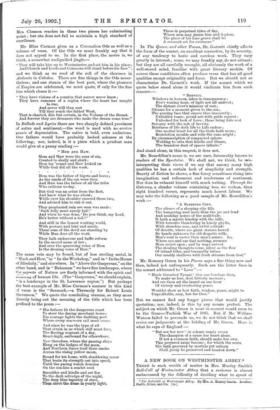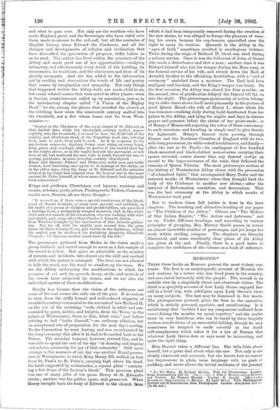A NEW BOOK ON WESTMINSTER ABBEY.* THERE is such wealth
of matter in Mrs. Murky Smith's Roll-Call of Westminster Abbey that a reviewer is almost embarrassed by the difficulty of deciding what to speak of
. .
• The Roti.Call of Westminster Abbey. By grs. Murray Spat. Loudon! Smith, Elder, and. do. [6s.) - .
and what to pass over. Not only are the worthies who have made England great, and the Sovereigns who have ruled over them, made to answer to the roll-call, but all the centuries of English history since Edward the Confessor, and all the changes and developments of religion and civilisation that have diversified the procession of progress, defile before us as we read. The author has lived within the precincts of the Abbey and made good use of her opportunities,—studying intimately and affectionately every detail of the building, its monuments, its traditions, and the characters and lives of its ghostly occupants. And she has added to the information got by reading and observation the touch of life and poetry that comes by imagination and sympathy. Not only things that happened within the Abbey walls are made vivid to us, but many related scenes that were acted in other places—even in foreign countries—are called up by association, just as in the introductory chapter called " A Vision of the Mighty Dead " we see, among the ghosts that crowded the church at the witching hour when the nineteenth century melted into
the twentieth, not a few whose bones rest far from West- minster :— " Seated in the blackness of the royal chapel of St. Edward on that fateful date, while the nineteenth century melted imper- ceptibly into the twentieth, I seemed to hear the Roll-Call of the mighty and illustrious dead, of the forgotten dead also, echoing from aisle to aisle, from arch to arch. As if in response to the mysterious summons, shadowy forms were rising on every hand, from grave and cenotaph alike, no matter if the mortal dust lay in the tombs above, or in the vaults beneath the pavement, or not here at all, but scattered far and wide in lands beyond the sea, or resting, perchance, in some peaceful country churchyard Kings and Queens, Princes and Princesses, noble men and noble women, were hastening once again to do homage at the shrine, as in the olden days, when the fame of St. Edward and the miracles worked at his tomb had eclipsed even the honour due to the more ancient St. Peter himself, in whose name the church had originally been consecrated."
Kings and artificers, Churchmen and laymen, warriors and monks, scholars, poets, actors, Plantagenets, Tudors, Common- wealth men, Stuarts, all are there, though— "It seemed as if there were a special rendezvous of the blood- royal of Stuart to-night, so many were present, and suddenly, in the midst of a group of children and grandchildren, one perceived a familiar form, a melancholy-visaged monarch, clad in the white shirt and red mantle of his coronation, who was walling with slow
and stately gait, none other than Charles I. himself, drawn from Windsor to-night by the fascination of this historic gather- ing. Not far off, with his mighty men around him, the grim figure of Oliver Cromwell was just visible in the darkness; within his mailed arm he sheltered his shrinking daughter, Elizabeth Claypole ; his Spartan mother stood erect by his side."
The personages gathered from Hades in the vision make a group brilliant and varied enough to serve as a fair sample of the crowd to follow. But quite as admirable as the number of persons and incidents introduced are the skill and method with which the matter is arranged. The trees are not allowed to hide the wood, nor the wood to swallow up the trees. We see the Abbey undergoing the modifications to which the progress of art and the growth, decay, strife, and revivals of the creeds have subjected its stones, and we see also the individual agents of these modifications.
Hardly less bizarre than the vision of the authoress are some of the real scenes she calls out of the past. It is curious to turn from the stiffly formal and well-ordered etiquette of twentieth-century ceremonial to the account of how Richard II.
on the eve of his crowning "rode, clothed in white and sur- rounded by peers, nobles, and knights, from the Tower to the palace at Westminster, there to dine, drink wine," and before retiring to bed " bathe himself,"—no ordinary ablution, but an exceptional rite of preparation for the next day's sacring. To the Coronation he went fasting, and was so exhausted' by the long ceremony that after it be had to be carried back to the Palace. The noonday banquet, however, revived him, and he was able to spend the rest of the day " in dancing and leaping and solemn minstrelsy for joy of that solemnity." Still more strange to the manners of our day was another Royal proces- sion to Westminster, in which King Henry III. walked on foot from St. Paul's to St. Peter's, carrying high above his head, his hand supported by ecclesiastics, a crystal phial " contain- ing a few drops of the Saviour's blood." This precious phial was one of many gifts of the pious Henry to St. Edward's shrine ; another was the golden spurs, still preserved. When Henry brought back the body of Edward to the church from
which it had been temporarily removed during the erection of the new shrine, he was obliged to forego the pleasure of wear- ing his crown because his cup-bearers quarrelled over the right to carry its cushion. Quarrels in the Abbey in the " ages of faith " sometimes resulted in sacrilegious violence. Twice during the reign of Richard II. blood was shed during a solemn service. Once it was the followers of John of Gaunt who made a disturbance and slew a man ; another time it was Richard himself who lost his temper during the Mass sung at the funeral service of his wife, and struck down the Earl of Arundel, brother to the officiating Archbishop, with a " rod of ceremony" snatched from a mourner. The Earl had been negligent and insolent, and the King's temper was hasty. On the first occasion, the Abbey was closed for four months ; on the second, rites of purification delayed the funeral till far on into the night. The picturesque spontaneity of action belong- ing to older times shows itself more pleasantly in the picture of good Queen Maud—the wife of Henry I., whose whole life was romance—walking daily during Lent barefooted from her palace to the Abbey, and lying for nights and days in sincere prayer and penance before the shrine of her great-uncle ; or of Henry of Monmouth rejecting the robes of State customary to such occasions, and kneeling in simple mail to give thanks for Agincourt. Henry's funeral train passing through France and the Southern Counties of England with its two- mile-long procession, its white-robed torchbearers, and finally— after the rest at St. Paul's—its contingent of five hundred black-mounted and black-clothed men-at-arms carrying their spears reversed, comes nearer than any funeral cortege on record to the impressiveness of the train that followed the remains of Queen Victoria. The most picturesque section of the history of Westminster Abbey closes with the procession " of a hundred lights " that accompanied Mary Tudor and the restored monks of Westminster when they brought back the body of the Confessor to another new shrine,—after the interval of Reformation vandalism and desecration. That was the last ceremony at the Abbey in which monks of Westminster took part.
But to modern times full justice is done in the later chapters. The touching and attractive heading of one paper is " The Children of the Abbey." Others are " The Makers of Our Indian Empire," " The Actors and Actresses," and so on. Under different headings, and according to various principles of grouping, Mrs. Murray Smith passes in review an almost incredible number of personages, and yet keeps her work within reading compass. The chapters are liberally illustrated, and some excellently clear plans of the Abbey are given at the end. Finally, there is a good index to complete the usefulness of the volume as a book of reference.







































 Previous page
Previous page